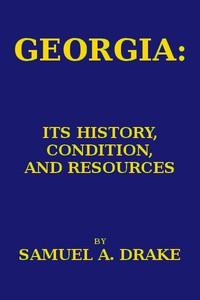Read this ebook for free! No credit card needed, absolutely nothing to pay.
Words: 11627 in 3 pages
This is an ebook sharing website. You can read the uploaded ebooks for free here. No credit cards needed, nothing to pay. If you want to own a digital copy of the ebook, or want to read offline with your favorite ebook-reader, then you can choose to buy and download the ebook.


: Georgia: Its History Condition and Resources by Drake Samuel Adams - Georgia Description and travel
Transcriber's Note:
Every effort has been made to replicate this text as faithfully as possible, including some inconsistent hyphenation. Some changes have been made. They are listed at the end of the text.
GEORGIA:
ITS HISTORY, CONDITION, AND RESOURCES
BY SAMUEL A. DRAKE
NEW YORK CHARLES SCRIBNER'S SONS 1879
GEORGIA.
Georgia, one of the thirteen original States of the American Union, has Tennessee and North Carolina on the N., South Carolina and the Atlantic Ocean on the E., Florida S., and Alabama W. The Savannah river separates the State on the E. from South Carolina; the St. Mary's, on the S., divides it in part from Florida; the Chattahoochee, on the W., flows between Georgia and Alabama for nearly half its course. Georgia lies between 30? 21? 39? and 35? N. lat., and between 81? and 85? 53? 38? W. long. It is 320 miles long from N. to S., and 256 miles in its greatest breadth from E. to W., with an area of 58,000 square miles.
The Savannah is formed of two small streams which rise near the North Carolina line, and unite on the boundary between S. Carolina and Georgia in Hart county. Flowing thence in a nearly S.S.E. direction for 450 miles, it enters the Atlantic near 32? N. lat. The Savannah is navigable from November to June. Ships ascend it 18 miles to the city of Savannah, steamboats to Augusta, 230 miles, and by means of a canal around the falls there, constructed in 1845, light draught vessels navigate it 150 miles higher. This canal, 9 miles long, furnishes the water-power of Augusta. The river is here about 300 yards wide. From Augusta the traveller descends the Savannah through the cotton-fields of the table-lands, and the long reaches of semi-tropical vegetation dominated by groves of live oak, to the rich rice plantations of the seaboard.
The Chattahoochee is one of the largest and most interesting rivers of Georgia. It rises on the declivity of the Blue Ridge, in Habersham county, in the N.E. of the State, pursues a devious S.W. course through the gold region of upper Georgia until it reaches West Point, on the Alabama frontier. It then flows nearly south to the Florida State line, where it is joined by the Flint, when the two streams flow on through Florida to the Gulf under the name of the Appalachicola. Large steamboats ascend the Chattahoochee in the season of navigation to Columbus, 350 miles from the Gulf. The whole estimated length of the river is 550 miles. The falls at Columbus create a valuable water-power, constituting that city one of the three important manufacturing centres of the State. Just above Columbus the Chattahoochee is broken in picturesque rapids, overlooked by a rocky cliff called the "Lover's Leap," which is the subject of an interesting legend. Besides Columbus, the towns of West Point and Fort Gaines are the most important on the Chattahoochee in Georgia; Appalachicola at its embouchure on the Gulf is its shipping and distributing port, but is decreasing in importance since the railway system of the State has assumed a large share of the traffic once confined to the navigable streams.
The Oconee and Ocmulgee rise near each other, in the N. of the State, flow through its centre to within 100 miles of the sea, when their united streams pass on S. E. to the Atlantic under the name of the Altamaha. Milledgeville, the former capital of Georgia, is on the Oconee, and Macon on the Ocmulgee. Darien on the Altamaha is reached by vessels drawing 11 to 14 feet of water. The Ogeechee, rising also in the north, is about 200 miles long. It drains the country between the Savannah and Altamaha, entering the Atlantic a few miles south of the Savannah. The Ogeechee is navigable for light vessels 30 or 40 miles, and for keel-boats to Louisville. The Santilla and St. Mary's drain the south-eastern counties, and are each navigable 30 or 40 miles for sloops. The Flint, Ockloconee, and Suwanee drain the south-western counties; the Flint is navigable to Albany, 250 miles from the Gulf, for steamboats. The Tallapoosa and Coosa, head-waters of the Alabama, and the Hiawassee, one of the sources of the Tennessee, rise in the mountains of Georgia--the last, however, finding its way to the Gulf of Mexico by the Ohio and Mississippi valleys.
Georgia has about 128 miles of sea-coast, but has few good harbors, except within the rivers emptying upon it. St. Mary's, Brunswick, Darien, and Savannah are the principal. The chain of islands lying off the mainland produces the celebrated Sea-island cotton, but owing to the changes brought about by the secession war it is now little cultivated. These islands are flat, and generally little elevated above the sea. Cumberland island, one of the most attractive, is nearly 30 miles long. It is covered with magnificent forests of oak, and its shores are skirted with palms, palmettos, and tropical shrubbery. Other islands from S. to N. are Jykill, St. Simon's, Sapello, St. Catharine's, Ossabaw, and Cabbage. The Sea Islands, with the main shore, constitute a coast of 480 miles. St. Andrew's, St. Simon's, Altamaha, Doboy, Sapello, St. Catharine's, and Ossabaw are the principal sounds.
Free books android app tbrJar TBR JAR Read Free books online gutenberg
More posts by @FreeBooks

: The Expositor's Bible: The Epistle of St Paul to the Romans by Moule H C G Handley Carr Glyn Nicoll W Robertson William Robertson Sir Editor - Bible. Romans Commentaries








